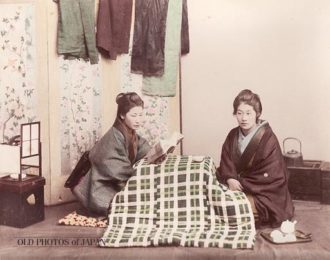
The Guimet museum of Asian Arts -located in Paris- includes in its collection a painting from Hokusai Katsushika (1760 – 1849) made of colorful inks and depicting two lovers laying down under a comforter. On the right side of the image, there is a rectangular box. For now, we are going to leave these two lovers from the Edo period and focus our attention on the box…
The kotatsu is a mobile table with a small fireplace of charcoal covered with a grid. The inhabitants of the house settle around this table, legs folded or lying under the table, to stay close to the warmth. This systems spreads the heat locally rather than in the entire room, reducing the consumption of coal. The whole thing can be covered with a blanket to insulate and keep the warmth underneath.
This invention traces back to the Muromachi era (14th century ). At that time, the kotatsu is called irori and refers to a charcoal fireplace to heat the kitchen. Later on, with the arrival of electricity, the kotatsu is modernized and an electric radiator is embedded under the wooden table.
The kotatsu is a good stimulator of conviviality during the cold months of winter. It defines a confortable space where the family can gather to discuss or play around a cup of tea.
It is a beautiful example of a low-tech solution, economical and ergonomic that could inspire western designers trying to solve fuel poverty situations.



